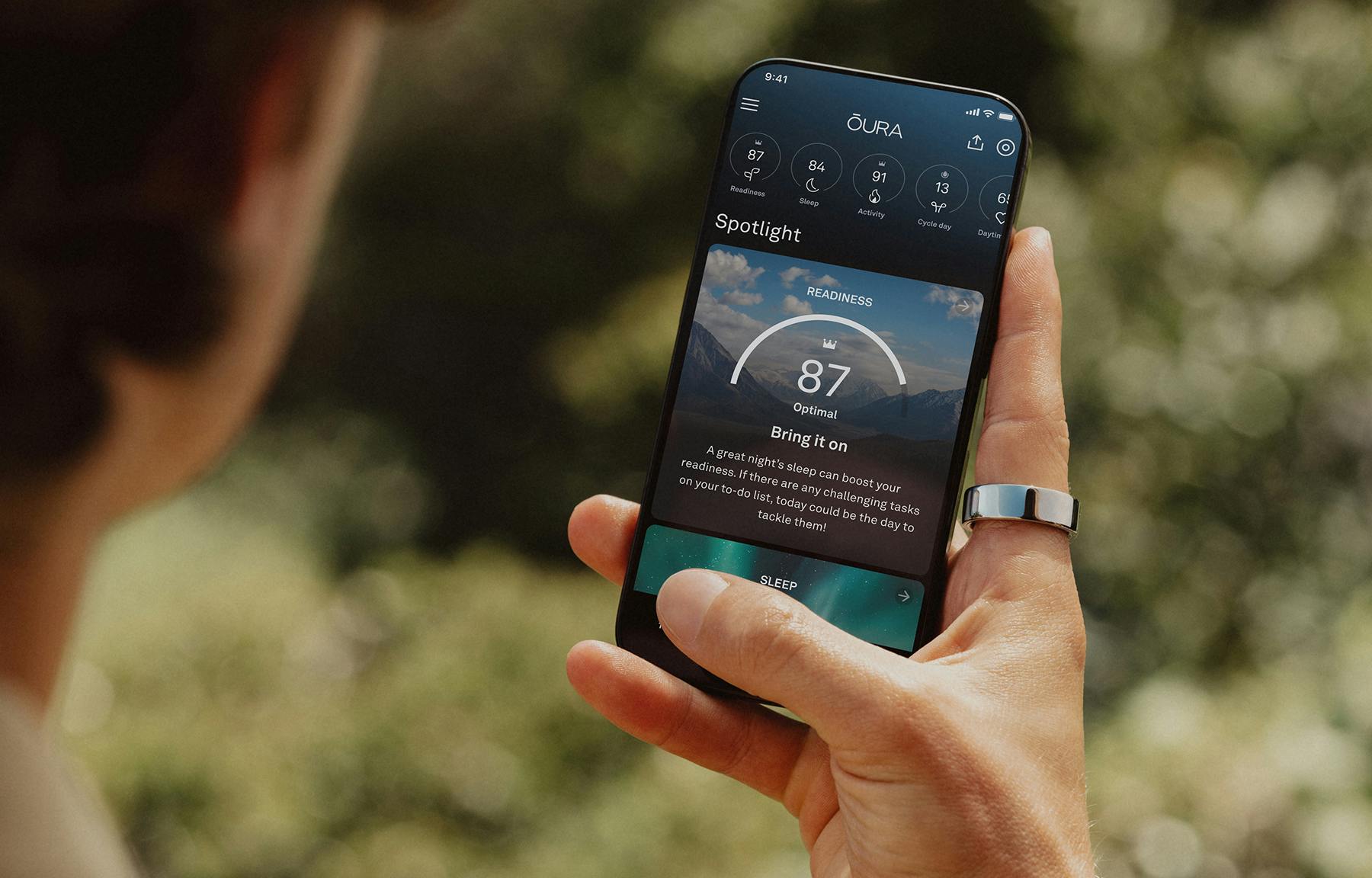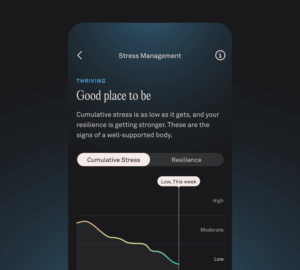Eating well shouldn’t feel like a math problem. Intuitive eating offers a refreshing approach to healthy eating, encouraging you to choose foods that fuel you—without having to count calories or macros.
Also known as mindful eating, intuitive eating helps you tune into your body’s natural hunger and fullness cues, and choose foods that leave you feeling energized, satisfied, and nourished.
Oura is here to help along the way, too: “Oura’s Meals and Glucose features highlight the effects of your dietary choices in a way that is more tangible and personalized than calorie or macro tracking,” explains Renee Wurth, PhD, RD, metabolic health scientific advisor at Oura.
READ MORE: Introducing Metabolic Health at Oura
What Is Intuitive Eating?
“Intuitive eating is all about tuning into your body’s physiological cues—like hunger, fullness, energy—and letting them guide how you eat,” Wurth notes. This contrasts with calorie counting, an approach that focuses on following blanket rules and restrictions.
Rather than labeling foods as “good” or “bad,” intuitive eating encourages curiosity. What foods make you feel energized and focused? Which meals lead to energy crashes or discomfort?
In other words, intuitive eating focuses on how food makes you feel. This mindful approach has been anecdotally successful, as well as supported in research. The best part? No foods are restricted. You’re encouraged to eat a variety of foods, so long as you eat them mindfully.
This approach was developed in 1995 by registered dietitians Evelyn Tribole and Elyse Resch, who created a 10-principle framework to help people move away from diet culture and toward a more connected, compassionate relationship with food.
How to Practice Intuitive Eating

Practicing intuitive eating means slowing down and tuning into your body to discover what you really need. Here’s how to get started:
- Check in before you eat. Ask yourself: Am I physically hungry? How hungry am I on a scale of 1 to 10? This helps distinguish true hunger from habit or emotion.
- Take your time. It can take up to 30 minutes for your brain to receive the signal from your stomach that you’re full. So when you eat quickly, you may still feel hungry. Slow down, avoid eating standing up, or while distracted. This helps you notice taste, texture, and fullness cues more easily—plus, it supports digestion.
- Try Oura Meals. By simply taking a photo of your meal, you receive actionable feedback from Oura Advisor that helps you make informed, sustainable choices based on how your meals impact energy, recovery, and metabolic health. Instead of tracking numbers, Meals provides visual insights into macronutrient balance, fiber, added sugars, and food processing levels.
- Notice how you feel after eating. For instance, you may notice that a carb-heavy meal makes you feel sleepy, or that eating fresh vegetables and lean protein makes you feel energized. Use Tags on Oura as well as Glucose data, if available, to spot patterns between what you eat and how your body responds.
- Enjoy eating foods that fuel you. Caloric restriction sometimes backfires. Your body needs fuel! Intuitive eating emphasizes permission to eat a wide range of foods, with attention to how those choices affect you. It replaces rigid rules with balance, and encourages mindful awareness rather than overindulgence.
- Experiment and adjust. Over time, you’ll learn what meals keep you feeling good and what throws you off. Let your body be your guide, and use the data to support the journey.
Remember: Intuitive eating is a skill, not a switch. With practice, and real-time feedback from Oura, you can build trust in your body and make choices that support your health for the long run.
RELATED: The Essential Guide to Eating for Metabolic Health
What the Science Says
Intuitive eating isn’t just a feel-good trend—it’s backed by a growing body of research that supports its benefits for both metabolic and mental health. Advantages may include:
- Better psychological health: A review of 97 studies found that intuitive eating is linked to improved self-esteem, body image, and overall wellbeing.
- Healthier eating behaviors: Studies indicate that intuitive eating is associated with reduced disordered eating behaviors, such as binge eating and chronic dieting.
- Greater diet quality: A 2021 study found that adults who self-reported as more intuitive eaters consumed more fruits and vegetables (about half a serving more) than those who scored lower, even after adjusting for various factors. These findings suggest that intuitive eating may support better diet quality without promoting restriction or calorie-focused behaviors.
- Improved adherence: A review of studies found that intuitive eating interventions led to improvements in eating behaviors, body satisfaction, and psychological health. Importantly, these programs showed high adherence (up to 92% completion) and sustained benefits for up to two years.
These findings support the idea that intuitive eating can be a valuable approach to promoting holistic health without the need for restrictive dieting.
| Member Tip: Oura’s Meals feature delivers key insights about meal timing and nutritional content, along with AI-powered feedback from Oura Advisor to help you make informed dietary decisions. All you have to do is take a picture of your meal, and Oura does the rest. |
Possible Drawbacks of Intuitive Eating
While intuitive eating offers a refreshing alternative to diet culture, it’s not always easy in practice, especially in today’s food environment, leading to a few potential drawbacks such as:
- Difficulty interpreting hunger and fullness cues: Chronic dieting and metabolic dysfunction can disrupt hormones like ghrelin, leptin, and insulin, making it harder to sense true hunger or satiety. Beyond this, even metabolically healthy people can struggle to interpret internal cues. For example, thirst is often mistaken for hunger.
- Nutrition knowledge gaps: Without a basic understanding of macronutrients, meal composition, or blood sugar, it’s hard to make informed food choices or identify what’s causing energy crashes or cravings. Plus, the “eat what you want” tagline of intuitive eating can be misinterpreted, leading to confusion about how to balance enjoyment with nutritional adequacy.
- Food access barriers: Even if you do know what you should be eating, it’s not always possible. Budget constraints, time constraints, or food access constraints (e.g. food deserts) can make it challenging to follow internal cues.
- May not be suitable for all: If you have an active eating disorder or metabolic dysfunction, intuitive eating may not be an appropriate approach. Always speak to a healthcare professional before starting any new eating approach.
- May not improve health outcomes: Individuals with obesity may need greater nutrition guidance. A pilot study found that calorie counting is more effective for weight management than intuitive eating.
What’s the Difference Between Calorie Counting and Intuitive Eating?
Calorie counting offers structure and can help some people understand how food impacts energy balance, but it also has limitations.
It can encourage fixation on numbers rather than how you actually feel, and it often overlooks other factors like sleep, stress, and metabolic health. Intuitive eating shifts the focus to internal cues—how satisfied, energized, or stable you feel after meals—without rigid tracking.
At Oura, we support a more holistic approach. We understand that metabolic health is dynamic, so instead of prescribing what or how much to eat, features like Meals and Glucose help you learn from your own patterns, so you can make food choices that support both your physiology and your lifestyle.











